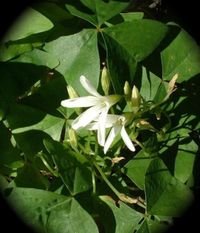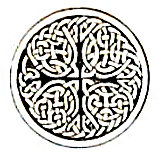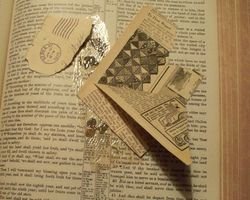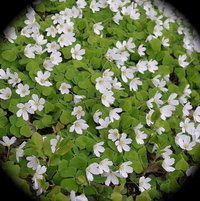





I spent half my life looking for shamrocks. Not four leafed clovers, mind you, but shamrocks. I was taught they were lucky, they would keep snakes away, and they were the plant of my Irish/Celt ancestors. Of course everything I ever did was blamed on ancestors, but I am sure if the truth be known, my genetic structure is linked to every tribe and clan that ever existed.
When I had a temper tantrum, they said I was on the warpath, just like my Cherokee ancestors. When I had a stroke of luck and didn't break my neck when I fell out of the tree, they said it was the luck of the Irish. When I painted decorations all over my 7-year-old body, they blamed it on our ancestral Celts who painted their bodies blue to scare away the enemies. With all that blood running through my veins, it is surprising that I am not covered in polka dots and stripes. Well, there were times when I was that, too. At any rate, I survived, genetic pool intact, surprising those who I am sure doubted I would make it till my teens.
I recently found one of those huge black family Bibles packed away in a box of treasures from a past life. It had belonged to my Granny Ninna, and it is quite brittle with age. I carefully leafed through its thousands of pages, and I found treasure after treasure within the covers of that book. Ninna saved every little piece of my life. I found enough pressed shamrocks to cover the wall of my bedroom. I never collected 4 leafed clovers when I was little, only perfect shamrocks. I tried to remember all the stories I was told about shamrocks, and why they were important to me. What follows is a lot of what I remember, some of what I found in research, and all of what Granny Ninna and Aunt Bett ever told me about shamrocks.
Wood sorrel, Oxalis acetosella, grows mostly in the shady soil of the woods, near rocks and on mossy banks. We found it growing in dappled sunlight alongside the stream that flowed down from the mountains. It is native to Eurasia, and is grown in and sometimes escapes from gardens in North America from Newfoundland to Saskatchewan, south to Wisconsin, Tennessee and North Carolina. It is a perennial herb that grows up to six inches tall from a creeping rootstock. Bright green basal leaves, three to eight together, are borne on long slender leafstalks, each leaf is divided into three leaflets. Solitary white flowers bloom from April to July on long slender stalks. The blooms are white with pinkish to purple veins.
The wood sorrel, or shamrock as most of us know it and as any true Irishman knows, has a tripartite leaf, and it was with this leaf the great St. Patrick is said to have explained the doctrine of the Trinity to the heathen Celts. Now this plant serves as the symbol of the Emerald Isle. Opinions vary about which plant is the true shamrock, but a strong case can be made for wood sorrel, which is native to the British Isles. In England, it was called cuckoo bread because it sprouted from the ground when that bird began his spring serenade.
I found a lot of legend and lore connected with the shamrock, most of it was told to me long ago, by whichever relative was claiming her Irish heritage at the time. It symbolizes the cross and the trinity to some cultures. Before Christianity, it was considered a sacred plant, and to the Druids of Ireland it was sacred because its leaves formed a triad. It is connected to St. Patrick in an interesting way as well. He was speaking from an open air pulpit, trying to convince the Celts to mend their crooked ways, and to illustrate the point he was making, he reached down to the ground and plucked a shamrock. He connected the triple leaf of the shamrock to the Trinity, and thus was his method of teaching the concept of the Trinity being three in one.
It also plays a part in the banishment of the serpent tribe of Ireland by a tradition that snakes are never seen near shamrocks, and by the claim that it was a remedy for snake and scorpion bite. I am sure St. Patrick played on these ancient beliefs, because the number three has been considered sacred in many cultures, particularly among the Celts to w hom he was preaching. It was easy to use something that they could relate to already, in order to get them to accept Christianity.
hom he was preaching. It was easy to use something that they could relate to already, in order to get them to accept Christianity.
Of course there is also the belief that great things come in threes, mystical things, things that cannot be explained: faith, hope and charity; past, present and future; yesterday, today and tomorrow; land, sea and sky; earth, fire and water. These were concepts that the older cultures understood, and it was easy for them to adapt new beliefs into their own. St. Patrick filled the Emerald Isle with lush fields of shamrocks, supposedly to keep snakes from ever returning, both the physical beings, and the heathen beliefs. People still say that shamrocks will grow wherever St. Patrick preached, and I have been told that there are no snakes in Ireland.
The shamrock is an early symbol that was found on bishops tombs, and on copper coins long before it was mentioned in any writings. "Seamrog", the Gaelic word for shamrock, was not found in writing until the early 1700s, and the term "Wearing of the Green" came about when Queen Victoria tried to rule the acquired Ireland. The Irish revolted and wore symbols of the shamrock against the oppression of the crown. Throughout the 19th century the shamrock was used as a decorative symbol on everything Irish, particularly churches and public buildings. It went beyond a spiritual symbol and became a symbol of empowerment and pride. In the 19th century there was also a great revival of Celtic art, particularly designs of the shamrock, and Celtic knotwork.
"Wearing of the Green" came about when Queen Victoria tried to rule the acquired Ireland. The Irish revolted and wore symbols of the shamrock against the oppression of the crown. Throughout the 19th century the shamrock was used as a decorative symbol on everything Irish, particularly churches and public buildings. It went beyond a spiritual symbol and became a symbol of empowerment and pride. In the 19th century there was also a great revival of Celtic art, particularly designs of the shamrock, and Celtic knotwork.
And believe it or not, the shamrock has a history of medicinal uses. It has a pleasantly sour flavor, trust me, I am very sure of that. I sucked the flavor right out of many shamrock stems, and it beats hard sour candy any day. In Elizabethan England it was a popular culinary herb, used as a salad ingredient, a potherb, and a sauce herb. Some ancients recommended the plant to quench thirst, and to strengthen a weak stomach. By the 1800's  this species of sorrel had been introduced into North America and one herbalist noted that a decoction, or extract, of wood sorrel was being used to treat inflammatory disorders, fevers and diseases of the kidneys and bladder. Even today's herbalists name it as an external wash or lotion, in treating skin infections, but there is no scientific basis for these claims.
this species of sorrel had been introduced into North America and one herbalist noted that a decoction, or extract, of wood sorrel was being used to treat inflammatory disorders, fevers and diseases of the kidneys and bladder. Even today's herbalists name it as an external wash or lotion, in treating skin infections, but there is no scientific basis for these claims.
I go through Granny Ninna's old family Bible, and I find memories. There is a yellowed brittle lined paper and on it, I must have held the leaf of the shamrock and pounded its green juices right into the paper. The green has not faded. And taped to another card, a Valentine for Ninna, there is a shamrock, along with the drawing of a heart and the words "I love you, Ninna". Those memories are treasures, and I can't believe Ninna kept them all. I am not sure that old Bible was meant to hold little girl treasures, but it sure does.
The legend of the shamrock has the power to comfort and to inspire, and so do those little things that grandmothers save in big family Bibles.
Happy St. Patrick's Day!
Please be sure to read Dutchlady1's article also about shamrocks here: http://davesgarden.com/guides/articles/view/692/
Sources: http://www.fantasy-ireland.com/
All photos are from Plant Files. Thanks to evert for the thumbnail, henryr10 for the close shot of the bloom, and trilian15 for the cluster of white blooms, all for the use of their great photos. The Celtic design is from Public Domain and the photo of the Bible and its treasures is my own.
(Editor's Note: This article was originally published on March 17, 2009. Your comments are welcome, but please be aware that authors of previously published articles may not be able to promptly respond to new questions or comments.)
Copyright © www.100flowers.win Botanic Garden All Rights Reserved